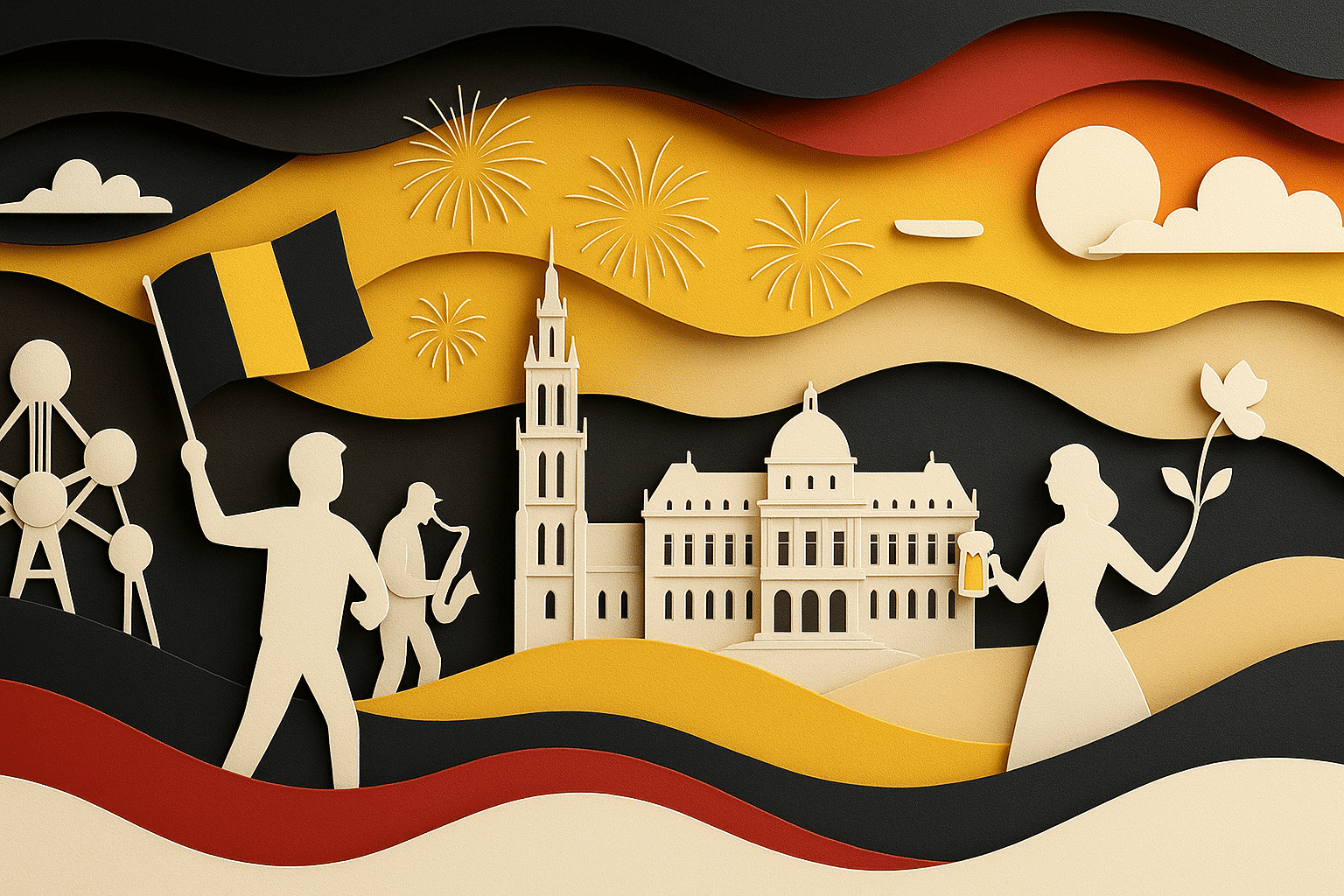What is Belgian National Day?
Belgian National Day is held every year on 21 July and is celebrated throughout Belgium. The date marks the moment in 1831 when Leopold I took the constitutional oath as the first King of the Belgians. It symbolises the start of Belgium’s independence after seceding from the Netherlands the year before. Belgian National Day is a civic celebration that brings together political institutions, military tradition and public festivities.
The day includes official ceremonies in Brussels and public events across the country. It is a rare moment of unity in a country often divided by language and region. Though not every Belgian celebrates the day in the same way, it remains a national holiday with widespread visibility. It is also a time when the monarchy plays a more public role than usual. Through military parades, concerts and fireworks, Belgian National Day reflects the country’s history and evolving identity.
History and Origin
The Kingdom of Belgium was established in the wake of the Belgian Revolution of 1830. After years of tension with the Dutch crown, the southern provinces declared independence. A provisional government was formed, and a national congress drafted a liberal constitution. In 1831, the young country invited Leopold of Saxe-Coburg and Gotha to become king. On 21 July 1831, he took the constitutional oath, formally becoming the first monarch of Belgium.
The choice of a monarch from abroad was strategic. Leopold was a Protestant German prince with connections across Europe, including Britain. His appointment helped give Belgium international recognition. Belgian National Day commemorates not just a coronation but the beginning of constitutional monarchy in the country. The day was first celebrated in 1890 and has since become the most important civic holiday in Belgium.
Over time, the way the day is marked has changed. In the early years, the focus was mainly royal and military. As society changed, new elements were added. Today, Belgian National Day blends political formality with cultural events. Local towns organise concerts, street festivals and firework shows. Though tensions still exist between regions, the day remains a shared marker of Belgian statehood.
Who participates in Belgian National Day?
- National institutions: Government, parliament and monarchy take part in official events and public ceremonies
- Military and police services: Perform in parades and displays, especially in Brussels
- Cultural organisations: Host concerts, theatre performances and open-air activities across regions
- Belgian families: Attend public celebrations, watch the parade or enjoy a day off together
- Tourists and expats: Join local events or observe the traditions of their adopted country
Slogans and Themes
Belgian National Day does not have fixed yearly slogans, but public messaging often centres around unity, democracy and pride. In some years, the theme highlights the role of the monarchy or the resilience of the state. In others, it focuses on civil service or national diversity. Whatever the theme, the tone tends to be formal but festive. Public broadcasts and speeches use the day to reflect on Belgium’s challenges and values.
Colors, Symbols and Patterns
Colors:
- Black: Represents strength and dignity
- Yellow: Symbolises generosity and the Belgian lion
- Red: Stands for bravery and the blood shed for freedom
Symbols:
- Belgian flag: Central to all displays, flown from public buildings and homes
- Crown and sceptre: Represent constitutional monarchy and authority
- Lion of Belgium: Used in both Flemish and Walloon heraldry as a national icon
Patterns:
- Tricolour stripes: Found in decorations, clothes and event banners
- Military formations: Seen in the parade, symbolising discipline and structure
- Royal insignia: Used in ceremonial uniforms and palace décor
Most Used Hashtags
- #BelgianNationalDay
- #Belgium21July
- #LeopoldI
- #BelgiumIndependence
- #FeteNationale
How do you celebrate Belgian National Day?
- Watch the military parade: Held in Brussels and broadcast nationally, it includes army, police and emergency services
- Attend a public concert: Cities like Brussels, Liège and Antwerp host free open-air performances
- Join local festivities: Towns across Belgium organise games, food markets and dancing
- Enjoy fireworks: The day often ends with a firework display, especially in the capital
- Visit symbolic sites: Monuments, museums and public buildings are open with special programmes
Why is Belgian National Day important?
Belgian National Day is important because it marks the foundation of the Belgian constitutional monarchy and the beginning of independent statehood. It serves as a reminder of the 1830 revolution and the adoption of a liberal constitution the following year. The date connects citizens to a shared political starting point, even in a country known for its regional and linguistic divisions. By commemorating the oath of Leopold I, the day reaffirms the nation’s commitment to democratic values and legal order. It is one of the few moments where Belgians from different backgrounds pause to acknowledge a common point in their national story.
The day also plays a role in maintaining institutional visibility. Through royal addresses, military parades and formal ceremonies, the public sees the state not just as an idea but as a functioning structure. It offers a sense of continuity, even as Belgium evolves. The monarchy, while largely symbolic, helps anchor the narrative of stability and unity. In this way, the day provides both a civic ritual and a symbolic centre of gravity.
Finally, Belgian National Day is a public event that mixes tradition with everyday enjoyment. Fireworks, concerts and street festivals make it approachable, while the official elements provide structure. It’s a day when history and present-day experience intersect. For many, the celebration is less about politics and more about coming together. That balance between seriousness and festivity makes the day relevant and enduring.
Features
- National
